#delphinoidea
Explore tagged Tumblr posts
Text
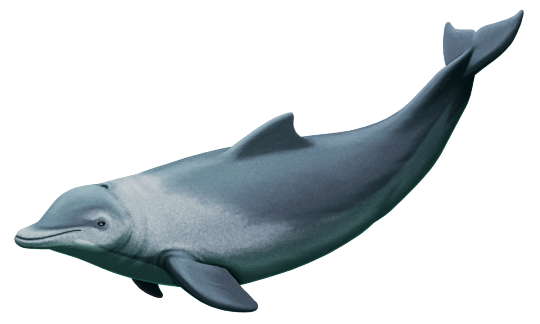
Albireonids were an early branch of the delphinoid whales, with their closest living relatives being modern oceanic dolphins, narwhals and belugas, and porpoises. Known from temperate latitudes of the North Pacific Ocean between the late Miocene and the late Pliocene, about 9-2.5 million years ago, their fossil remains are very rare in coastal deposits and they seem to have primarily been offshore open ocean animals.
Albireo whistleri is the best known member of this family, represented by a near-complete skeleton from what is now Isla de Cedros in Baja California, Mexico, dating to the late Miocene between about 8 and 6 million years ago. It was a rather small dolphin, around 2.5m long (~8'2"), with a stocky body, fairly broad flippers, and skull anatomy with some convergent similarities with the modern Dall's porpoise.
Interestingly these dolphins also seem to have frequently had pathological neck vertebrae, with both Albireo whisteri and the younger species Albireo savagei from California, USA, showing unusually asymmetrical atlas bones – but on opposite sides to each other. This might be due to illness or injury earlier in life, or possibly be evidence of some sort of "handedness" with individuals preferring to perform some actions more with one side of their body than the other.
———
NixIllustration.com | Tumblr | Patreon
References:
"Albireonidae." Paleobiology Database, https://paleobiodb.org/classic/checkTaxonInfo?taxon_no=42961
Barnes, Lawrence G. Fossil odontocetes (Mammalia: Cetacea) from the Almejas Formation, Isla Cedros, Mexico. University of California, Museum of Paleontology, 1984. https://books.google.com/books?id=rxyydMGWGqgC
Barnes, Lawrence G. "Miocene and Pliocene Albireonidae (Cetacea, Odontoceti), rare and unusual fossil dolphins from the eastern North Pacific Ocean." Natural History Museum of Los Angeles County Science Series 41 (2008): 99-152. https://www.researchgate.net/profile/Xiaoming-Wang-43/publication/252086599_Geology_and_Vertebrate_Paleontology_of_Western_and_Southern_North_America/links/5625900908ae4d9e5c4bb863/Geology-and-Vertebrate-Paleontology-of-Western-and-Southern-North-America.pdf#page=105
Gillet, Amandine, Bruno Frédérich, and Eric Parmentier. "Divergent evolutionary morphology of the axial skeleton as a potential key innovation in modern cetaceans." Proceedings of the Royal Society B 286.1916 (2019): 20191771. https://doi.org/10.1098/rspb.2019.1771
Thomas, Howell W., et al. "Examples of paleopathologies in some fossil Cetacea from the North Pacific realm." Natural History Museum of Los Angeles County Science Series 41 (2008): 153-179. https://www.researchgate.net/profile/Xiaoming-Wang-43/publication/252086599_Geology_and_Vertebrate_Paleontology_of_Western_and_Southern_North_America/links/5625900908ae4d9e5c4bb863/Geology-and-Vertebrate-Paleontology-of-Western-and-Southern-North-America.pdf#page=159
#science illustration#paleontology#paleoart#palaeoblr#albireo#albireonidae#delphinoidea#dolphin#odontoceti#cetacean#whale#artiodactyla#ungulate#mammal#marine mammals#art#paleopathology
270 notes
·
View notes
Photo
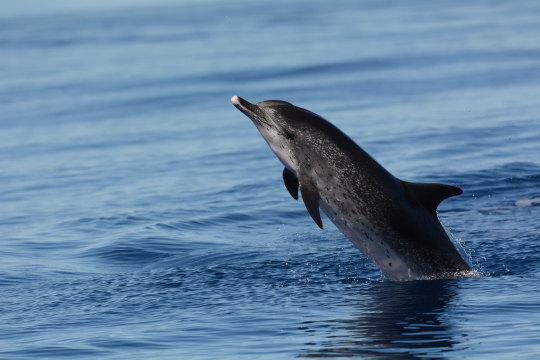
Atlantic spotted dolphin (Stenella frontalis)
Photo by Sylvere Corre
#atlantic spotted dolphin#dolphin#stenella frontalis#stenella#delphininae#delphinidae#delphinoidea#odontoceti#cetacea#whippomorpha#cetruminantia#artiofabula#artiodactyla#euungulata#scrotifera#laurasiatheria#boreoeutheria#eutheria#mammalia#tetrapoda#vertebrata#chordata
46 notes
·
View notes
Photo

A Risso’s dolphin caught up in fishing line. Dolphin numbers in the Indian Ocean may have dropped by more than 80% in recent decades, with an estimated 4 million small cetaceans caught as “by-catch” in commercial tuna fishing nets since 1950, according to a study
Photograph: Andrew Sutton/Central Studio
(via The week in wildlife – in pictures | Environment | The Guardian)
#Risso's Dolphin#Grampus griseus#Grampus#Globicephalinae#Delphinidae#Delphinoidea#Odontoceti#Cetacea#Whippomorpha#Artiodactyla#Mammalia#mammal#marine mammal#dolphin#ocean#marine life#plastic#fishing#fishing industry#fishing line#environment
11 notes
·
View notes
Note
Regarding the comment “Orcas aren’t even whales you idiot they’re fucking dolphins lol”…. Because dolphins definitely aren’t whales!
For somebody who’s so sure they know more about cetaceans than you do, you’d think they’d have encountered the fact that neither whale nor dolphin are terms tied to strict taxonomic definitions (dolphins aren’t all one lineage after all), and whale is useful as a blanket term for all cetaceans (you know, like “toothed whales”, the things dolphins are). All the large beakless dolphins except Risso’s dolphins are called whales — indicating that if whale has any definition it’s a size-based one which killer whales absolutely would fit.
Here’s my message for that guy:
I’m an idiot? For referring to a member of the species Orcinus orca by the widely accepted colloquial name ‘killer whale’? Indeed, the orca is a member of the taxonomic family Delphinidae—the oceanic dolphins. But Delphinidae itself is but a subset of the superfamily Delphinoidea, which includes not only Delphinidae but also Phocoenidae (porpoises) and Monodontidae (belugas and narwhals). And Delphinoidea, in turn, joins with the sperm and beaked whales to form the cetacean parvorder Odontoceti—the odontocetes. More commonly know as…
THE TOOTHED WHALES.
#orcas are whales because they are dolphins and dolphins are a type of whale#orcas#killer whales#dolphins#whales#cetaceans#asks
11 notes
·
View notes
Text
Ok so fun fact: I have a very irrational but also somewhat minor fear of Delphinoidea, which oddly started when I saw footage of belugas at night. Big whales? 100% fine those are friends but these small toothed fucks always make me uncomfortable. River dolphins particular freak me out but not so much in image form. These fucks look malicious. These are the devil.

bro, we wake up to come hang with you. we come over to hang out with you. we are here for you. bro.
34K notes
·
View notes
Note
number THIRTEEN, also known as DOVE JOHANSSON was born in 1992! SHE has always been known for their DELPHINOIDEA PHYSIOLOGY! they identify as FEMALE and are BISEXUAL. they have been called ADAPTABLE as well as DISTRUSTFUL and just so happen to resemble DIANNA AGRON! [ chelsea / 22 / est / she/her ]
hey lovely. sadly all of our 1992 children spots are now taken. if you have another muse in mind we’d love to have you join us !

1 note
·
View note
Photo
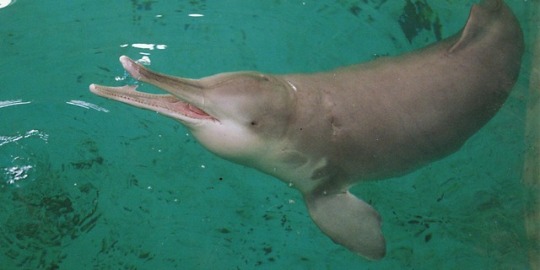
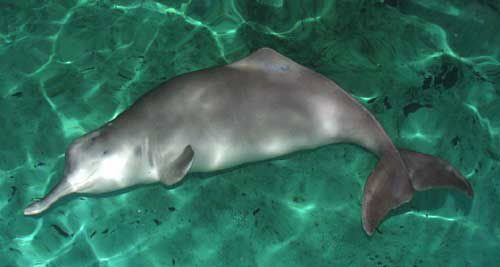
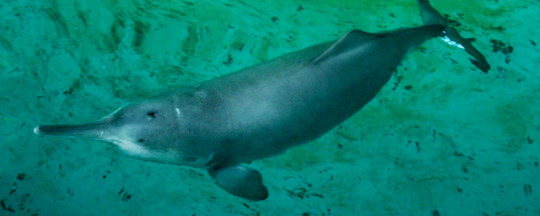
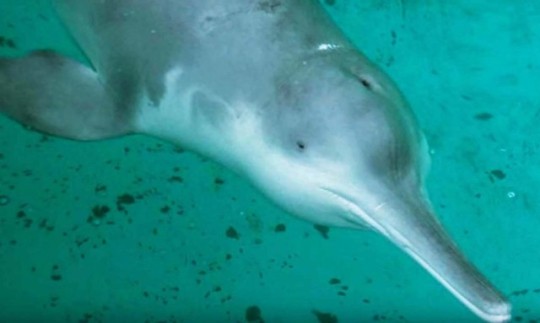
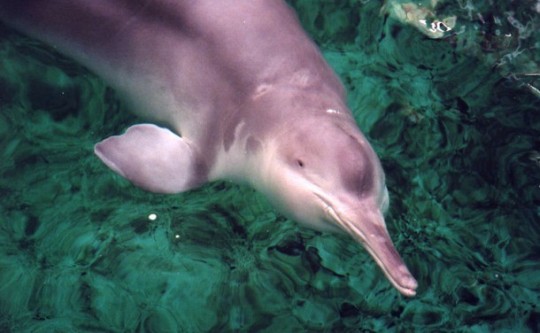
Endangered cetaceans, part 3
Baiji, Lipotes velixifer
Everyone who knows about recently extinct animals or endangered cetaceans must know about the Baiji, or the Yangtze River dolphin.
Declared extinct in 2006, I would include them here even if that fact was standing, but in 2016, at least one Baiji was spotted in Yangtze River. That means the dolphin is not actually extinct, but in essence functionally extinct, meaning there is virtually no chance for the species to recover. If that 2016 dolphin is still alive, and possibly more individuals not spotted, they are most likely sentenced to a lonely death in the garbage-ridden river.
And this is what the river looks like.

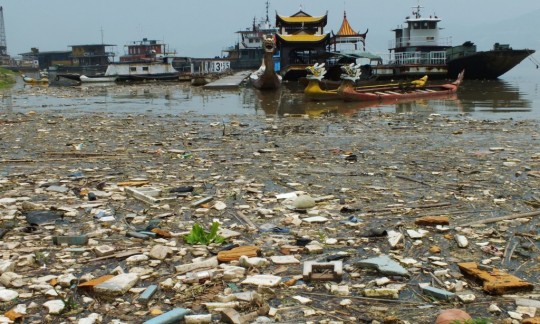
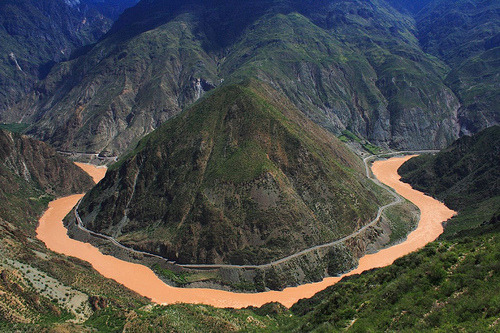
Nothing can live there indefinitely. Poisoning from an industrial nation gone out of hand, and garbage floating everywhere.
I feel for the people living there as well, but I do wonder how they could let it go this far. Thankfully, China is changing rapidly and hopefully they will have the Yangtze cleared soon. But even if it is crystal clear tomorrow, it would come too late for the Baiji.
The Baiji is one of four river dolphin species in the world, and completely unique. To put things into perspective, most of us know that killer whalses and pilot whales are dolphins. They are in the oceanic dolphin family, Delphindae. Porpoises, belugas and narwhals are in two separate families, but they are still in the dolphin superfamily, Delphinoidea.
River dolphins on the other hand split off from the other toothed whales such a long time ago, they are their own three separate superfamilies, the Baiji the sole member of theirs, Lipotoidea.
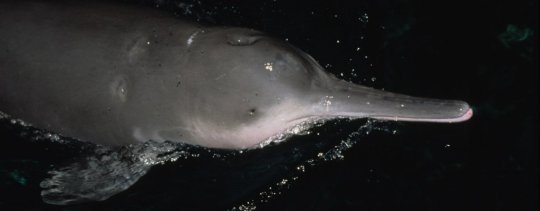
Also known as the Goddess of the Yangtze, and actually considered a goddess of protection by fishermen, their population was around 6000 strong in the 1950s, stretching across 1700 kilometers of the Yangtze.
After that, industrialization hit China hard, the communist regime destroyed the animal's revered status as a goddess, and they were pushed aside in the name of "progress". By 1979, the dolphin was endangered, and by 1983, directly killing the dolphin became illegal. By 1990, there were only 200 dolphins left, and six years later, they were deemed critically endangered. In 1996, a dead dolphin was found with over 100 open wounds on its body.
Reports came in of a dead baiji found with 103 separate open wounds; baiji with crushed skulls and dolphins sliced in two; and a pod of four baiji – two of them pregnant females – killed by explosions used to clear waterways in central China’s Hubei province. What stunned another expedition member, Yao Zhiping, was the amount of shipping on the river. On south China’s Poyang Lakealone, she counted 1,200 sand dredgers before giving up.
By 1998, only seven could be found in a survey, and the last one was spotted in the wild in 2004, with the last in captivity - a rescue from the early 1980s named Qi-Qi - dying in 2002. By 2006, not a single dolphin could be found in a six-week search, and they were declared extinct.
I was fifteen then, I remember reading this and crying. I had read about them in a magazine when I was eight, how there were only a handful left. And now they were gone, thanks to a lethal cocktail of dam-building, over-fishing, pollution and boat traffic.
Today, approximately 12% of the world’s human population lives and works within the Yangtze River catchment area.
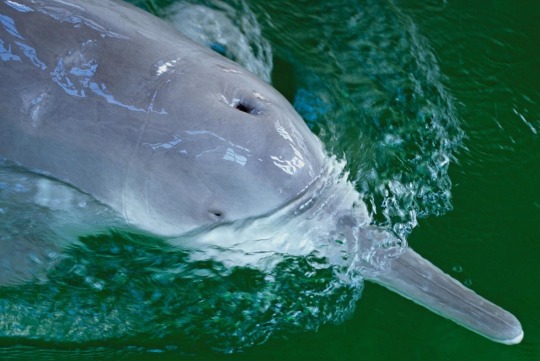
But by late 2016, news came that the dolphin had been spotted again. There is no hard proof, no photos or footage, and the people who spotted it are not considered professionals.
“No other creature could jump out of the Yangtze like that,” Song Qi, the leader of that expedition told Sixth Tone, a government-backed news website. “All the eyewitnesses – which include fishermen – felt certain that it was a baiji.”
But even if we believe them (I personally do) and they are right, and as I said, there could be more than that one, the species is still doomed. There are too few of them left, and the river is nowhere near becoming a good habitat for them.
Their scientific name means "flag-bearer left behind".
They lived in the Yangtze River for 20 million years. We wiped them out in half a century.
https://en.wikipedia.org/wiki/Baiji
https://www.chinadialogue.net/article/show/single/en/673-Farewell-to-the-baiji
https://www.theguardian.com/world/2016/oct/11/china-extinct-dolphin-returned-yangtze-river-baiji
58 notes
·
View notes
Photo

Humpsnout
Kingdom: Animalia
Phylum: Chordata
Class: Mammalia
Order: Artiodactyla
Suborder: Whippomorpha
Infraorder: Cetacea
Parvorder: Odontoceti
Superfamily: Delphinoidea
Family: Monodontidae
Genus: Odobenocetus
Species: O. borealis (”northern walking tooth”)
Ancestral species: Delphinapterus leucas (Beluga whale)
Time period: late Nyctocene to early Solocene (97 million years ago to 120 million years in the future).
Information: named after the large arch at the front of its skull, the Humpsnout is a 15-foot-long grey-colored whale found across much of the Arctic Sea, as well as some of the regions south of it, such as eastern Thalassia. Peculiarly for a whale, it is an herbivore, and feeds on primarily kelp. Like the False Manatee, it is a staple part of the aquatic ecosystem, being predated upon by a variety of large predators. The large arch on its head is filled with oil, and helps the animal to echolocate.
0 notes
Text
Strange Symmetries #22: The Whalerus And The Twisted Tusks
Mammalian tusks usually grow in symmetrical pairs with only minor developmental asymmetry, but a few species have evolved much more uneven arrangements.
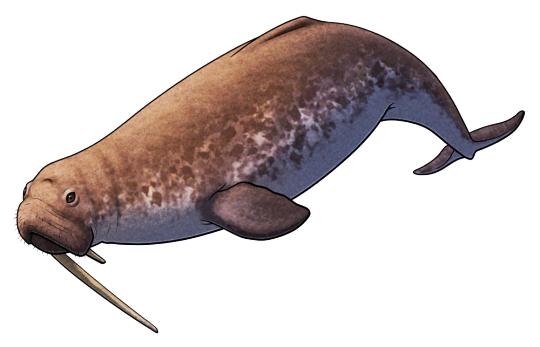
Odobenocetops peruvianus was a small toothed whale that lived during the Miocene, about 7-3 million years ago, in shallow coastal waters around what is now Peru. Around 3m long (~10'), it was a highly unusual cetacean with binocular vision, a vestigial melon, muscular lips, and a pair of tusks – features convergent with walruses that suggest it had a similar lifestyle suction-feeding on seafloor molluscs and crustaceans.
In males the right tusk was much more elongated than the left, measuring around 50cm long (~1'8") in this species and up to 1.35m (4'5") in the closely related Odobenocetops leptodon. Since these teeth were quite fragile they probably weren't used for any sort of combat, and they may have instead served more of a visual display function.
And despite being closer related to modern narwhals and belugas than to other toothed whales, Odobenocetops' long right-sided asymmetric tusks actually seem to have evolved completely independently from the iconic left-sided asymmetric spiral tusks of narwhals.
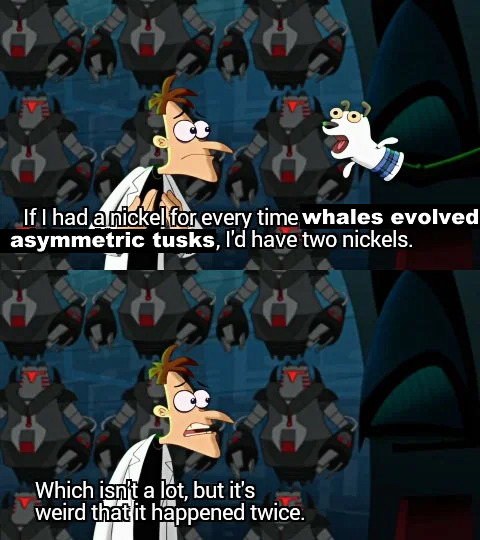
———

The woolly mammoth (Mammuthus primigenius) lived across Eurasia and North America during the last ice age, mostly from the Pleistocene about 400,000 years ago to the early Holocene about 10,000 years ago – altohugh a few relict populations survived until around 4,000 years ago in isolated areas of Alaska, Siberia, and eastern Russia.
Around 3m tall at the shoulder (~10ft), these hairy proboscideans had very long curving tusks that were used for digging out vegetation from under snow and ice, scraping bark from trees, and for fighting.
The tusks showed a lot of variation in their curvature, and were often rather asymmetrical, a condition also seen in the closely related Columbian mammoth. Like modern elephants mammoths may have also favored using one side over the other for certain tasks, which over their lifetimes could result in uneven wear exaggerating the natural asymmetry even more.
———
NixIllustration.com | Tumblr | Twitter | Patreon
#science illustration#strange symmetries#paleontology#paleoart#palaeoblr#tusks#odobenocetops#delphinoidea#odontoceti#toothed whale#cetacean#whale#artiodactyla#ungulate#marine mammal#woolly mammoth#mammuthus#elephant#proboscidea#afrotheria#mammal#art#whalerus#behold‚ a walrus!
352 notes
·
View notes
Photo

Atlantic spotted dolphin (Stenella frontalis)
Photo by Pedro Madruga
#atlantic spotted dolphin#dolphin#stenella frontalis#stenella#delphininae#delphinidae#delphinoidea#odontoceti#cetacea#whippomorpha#cetruminantia#artiofabula#artiodactyla#euungulata#scrotifera#laurasiatheria#boreoeutheria#eutheria#mammalia#tetrapoda#vertebrata#chordata
106 notes
·
View notes
Photo

Modern beluga whales and narwhals are the only living representatives of the monodontid lineage, found only in cold Arctic and sub-Arctic waters. But this whale family actually first evolved in much warmer climates – and some of them were downright tropical.
Casatia thermophila lived about 5 million years ago during the early Pliocene, in the Mediterranean Sea around Tuscany, Italy. Although known only from a couple of partial skulls and a few vertebrae it was probably similar in size to its modern relatives, around 5m long (16'4").
It seems to have had a larger number of functional teeth than modern monodontids, and probably didn't suction feed like its modern close relatives. Instead it may have fed more like most porpoises and dolphins, relying more on speed and snapping jaws to capture prey.
It inhabited the Mediterranean at a time not long after the sea there had mostly dried up and then been rapidly refilled. The presence of warm-water marine species such as bull sharks, tiger sharks, and dugongs in the same fossil beds as Casatia indicates the local climate at the time was hotter than it is today, with tropical temperatures – and suggests that this whale's ancestors must have originally moved into the replenishing Mediterranean from lower latitudes alongside these other warmth-adapted animals.
This tropical monodontid was also much closer related to modern belugas than modern narwhals are, which raises the possibility that the two living monodontid species actually specialized for colder conditions completely independently of each other rather than descending from a cold-adapted common ancestor. Instead modern belugas and narwhals may have originated from separate warm-water monodontid ancestors who evolved similar cold-tolerant adaptations in parallel as the climate cooled during the onset of the Quaternary ice age, while the rest of their relatives all went extinct.
———
Nix Illustration | Tumblr | Twitter | Patreon
#science illustration#paleontology#paleoart#palaeoblr#casatia#monodontidae#delphinoidea#odontoceti#toothed whale#cetacean#whale#whippomorpha#artiodactyla#ungulate#mammal#marine mammals#art
393 notes
·
View notes
Photo

Atlantic white-sided dolphin (Lagenorhynchus acutus)
Photo by Paul Jones
#atlantic white sided dolphin#dolphin#lagenorhynchus acutus#lagenorhynchus#delphininae#delphinidae#delphinoidea#odontoceti#cetacea#whippomorpha#cetruminantia#artiofabula#artiodactyla#euungulata#scrotifera#laurasiatheria#boreoeutheria#eutheria#mammalia#tetrapoda#vertebrata#chordata
56 notes
·
View notes
Photo

Common bottlenose dolphin (Tursiops truncatus)
Photo by Caroline Legg
#common bottlenose dolphin#bottlenose dolphin#tursiops truncatus#tursiops#delphininae#delphinidae#delphinoidea#odontoceti#cetacea#whippomorpha#cetruminantia#artiofabula#artiodactyla#euungulata#scrotifera#laurasiatheria#boreoeutheria#eutheria#mammalia#tetrapoda#vertebrata#chordata
14 notes
·
View notes
Photo
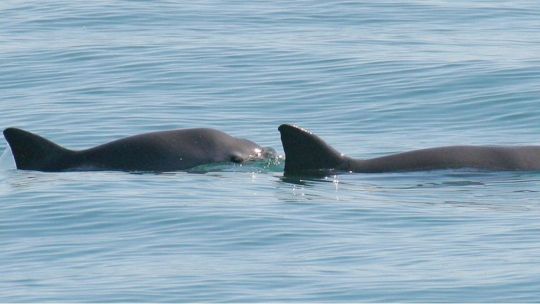
Vaquita (Phocoena sinus)
Photo by Don Johnston
#vaquita#cochito#desert porpoise#gulf porpoise#phocoena sinus#phocoena#phocoenidae#delphinoidea#odontoceti#cetacea#whippomorpha#cetruminantia#artiofabula#artiodactyla#euungulata#scrotifera#laurasiatheria#boreoeutheria#eutheria#mammalia#tetrapoda#vertebrata#chordata
9 notes
·
View notes
Photo

Hector's dolphin (Cephalorhynchus hectori)
Photo by Steve Reekie
#hector's dolphin#cephalorhynchus hectori#cephalorhynchus#cephalorhynchinae#delphinidae#delphinoidea#odontoceti#cetacea#whippomorpha#cetruminantia#artiofabula#artiodactyla#euungulata#scrotifera#laurasiatheria#boreoeutheria#eutheria#mammalia#tetrapoda#vertebrata#chordata
10 notes
·
View notes
Photo

Hector's dolphin (Cephalorhynchus hectori)
Photo by Torrie_Monster
#hector's dolphin#cephalorhynchus hectori#cephalorhynchus#cephalorhynchinae#delphinidae#delphinoidea#odontoceti#cetacea#whippomorpha#cetruminantia#artiofabula#artiodactyla#euungulata#scrotifera#laurasiatheria#boreoeutheria#eutheria#mammalia#tetrapoda#vertebrata#chordata
11 notes
·
View notes